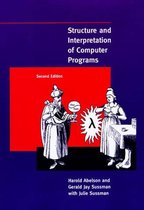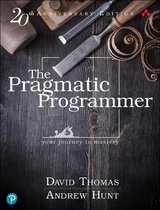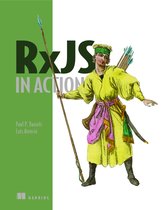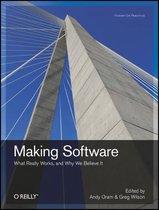Beautiful Code Les principaux programmeurs expliquent comment ils Think
Auteur:
Andy Oram
Greg Wilson
- en
- Broché
- 9780596510046
- 17 juillet 2007
- 456 pages
Résumé
How do the experts solve difficult problems in software development? In this unique and insightful book, leading computer scientists offer case studies that reveal how they found unusual, carefully designed solutions to high-profile projects. You will be able to look over the shoulder of major coding and design experts to see problems through their eyes. This is not simply another design patterns book, or another software engineering treatise on the right and wrong way to do things. The authors think aloud as they work through their project's architecture, the tradeoffs made in its construction, and when it was important to break rules. Beautiful Code is an opportunity for master coders to tell their story. All author royalties will be donated to Amnesty International. The book includes the following contributions: Beautiful Brevity: Rob Pike's Regular Expression Matcher by Brian Kernighan, Department of Computer Science, Princeton University; Subversion's Delta Editor: Interface as Ontology by Karl Fogel, editor of QuestionCopyright.org , Co-founder of Cyclic Software, the first company offering commercial CVS support; The Most Beautiful Code I Never Wrote by Jon Bentley, Avaya Labs Research; Finding Things by Tim Bray, Director of Web Technologies at Sun Microsystems, co-inventor of XML 1. 0; Correct, Beautiful, Fast (In That Order): Lessons From Designing XML Validators by Elliotte Rusty Harold, Computer Science Department at Polytechnic University, author of Java I/O, Java Network Programming , and XML in a Nutshell (O'Reilly); and, The Framework for Integrated Test: Beauty through Fragility by Michael Feathers, consultant at Object Mentor, author of Working Effectively with Legacy Code (Prentice Hall). It also includes: Beautiful Tests by Alberto Savoia, Chief Technology Officer, Agitar Software Inc; On-the-Fly Code Generation for Image Processing by Charles Petzold, author Programming Windows and Code: The Hidden Language of Computer Hardware and Software (both Microsoft Press); Top Down Operator Precedence by Douglas Crockford, architect at Yahoo! Inc, Founder and CTO of State Software, where he discovered JSON; Accelerating Population Count by Henry Warren, currently works on the Blue Gene petaflop computer project Worked for IBM for 41 years; Secure Communication: The Technology of Freedom by Ashish Gulhati, Chief Developer of Neomailbox, an Internet privacy service Developer of Cryptonite, an OpenPGP-compatible secure webmail system; and, Growing Beautiful Code in BioPerl by Lincoln Stein, investigator at Cold Spring Harbor Laboratory - develops databases and user interfaces for the Human Genome Project using the Apache server and its module API. It also includes: The Design of the Gene Sorter by Jim Kent, Genome Bioinformatics Group, University of California Santa Cruz; How Elegant Code Evolves With Hardware: The Case Of Gaussian Elimination by Jack Dongarra, University Distinguished Professor of Computer Science in the Computer Science Department at the University of Tennessee, also distinguished Research Staff member in the Computer Science and Mathematics Division at Oak Ridge National Laboratory (ORNL) and Piotr Luszczek, Research Professor at the University of Tennessee; Beautiful Numerics by Adam Kolawa, co-founder and CEO of Parasoft; and, The Linux Kernel Driver Model by Greg Kroah-Hartman, SuSE Labs/Novell, Linux kernel maintainer for driver subsystems, author of Linux Kernel in a Nutshell , co-author of Linux Device Drivers, 3rd Edition (O'Reilly). It also includes: Another Level of Indirection by Diomidis Spinellis, Associate Professor at the Department of Management Science and Technology at the Athens University of Economics and Business, Greece; An Examination of Python's Dictionary Implementation by Andrew Kuchling, longtime member of the Python development community, and a director of the Python Software Foundation; Multi-Dimensional Iterators in NumPy by Travis Oliphant, Assistant Professor in the Electrical and Computer Engineering Department at Brigham Young University; and, A Highly Reliable Enterprise System for NASAs Mars Rover Mission by Ronald Mak, co-founder and CTO of Willard & Lowe Systems, Inc, formerly a senior scientist at the Research Institute for Advanced Computer Science on contract to NASA Ames. It also includes: ERP5: Designing for Maximum Adaptability by Rogerio de Carvalho, researcher at the Federal Center for Technological Education of Campos (CEFET Campos), Brazil and Rafael Monnerat, IT Analyst at CEFET Campos, and an offshore consultant for Nexedi SARL; A Spoonful of Sewage by Bryan Cantrill, Distinguished Engineer at Sun Microsystems, where he has spent most of his career working on the Solaris kernel; Distributed Programming with MapReduce by Jeff Dean and Sanjay Ghemawat, Google Fellows in Google's Systems Infrastructure Group; Beautiful Concurrency by Simon Peyton Jones, Microsoft Research, key contributor to the design of the functional language Haskell, and lead designer of the Glasgow Haskell Compiler (GHC); and, Syntactic Abstraction: The syntax-case expander by Kent Dybvig, Developer of Chez Scheme and author of the Scheme Programming Language. It also includes: Object-Oriented Patterns and a Framework for Networked Software by William Otte, a Ph.D. student in the Department of Electrical Engineering and Computer Science (EECS) at Vanderbilt University and Doug Schmidt, Full Professor in the Electrical Engineering and Computer Science (EECS) Department, Associate Chair of the Computer Science and Engineering program, and a Senior Research Scientist at the Institute for Software Integrated Systems (ISIS) at Vanderbilt University; Integrating Business Partners the RESTful Way by Andrew Patzer, Director of the Bioinformatics Program at the Medical College of Wisconsin; and, Beautiful Debugging by Andreas Zeller, computer science professor at Saarland University, author of Why Programs Fail: A Guide to Systematic Debugging (Morgan Kaufman). It also includes: Code That's Like an Essay by Yukihiro Matsumoto, inventor of the Ruby language; Designing Interfaces Under Extreme Constraints: the Stephen Hawking editor by Arun Mehta, professor and chairman of the Computer Engineering department of JMIT, Radaur, Haryana, India; Emacspeak: The Complete Audio Desktop by TV Raman, Research Scientist at Google where he focuses on web applications; Code in Motion by Christopher Seiwald, founder and CTO of Perforce Software and Laura Wingerd, vice president of product technology at Perforce Software, author of Practical Perforce (O'Reilly); and, Writing Programs for 'The Book' by Brian Hayes who writes the Computing Science column in American Scientist magazine, author of Infrastructure: A Field Guide to the Industrial Landscape (W.W. Norton).
Spécifications produit
Nous n'avons trouvé aucune spécification pour votre recherche '{SEARCH}'.
Contenu
- Langue
- en
- Binding
- Broché
- Date de sortie initiale
- 17 juillet 2007
- Nombre de pages
- 456
- Illustrations
- Avec illustrations
Personnes impliquées
- Auteur principal
- Andy Oram
- Deuxième auteur
- Greg Wilson
- Rédacteur en chef
- Andy Oram
- Deuxième rédacteur
- Greg Wilson
- Editeur principal
- O'Reilly
Autres spécifications
- Hauteur de l'emballage
- 37 mm
- Hauteur du produit
- 38 mm
- Largeur d'emballage
- 179 mm
- Largeur du produit
- 184 mm
- Livre d‘étude
- Oui
- Longueur d'emballage
- 234 mm
- Longueur du produit
- 235 mm
- Poids de l'emballage
- 1290 g
- Police de caractères extra large
- Non
EAN
- EAN
- 9780596510046
Vous trouverez cet article :
- Catégories
- Langue
- Anglais
- Livre, ebook ou livre audio ?
- Livre
- Disponibilité
- Disponible à l'adresse suivante
Choisissez la version souhaitée
Choisissez votre binding
(2)
Informations sur les prix et commande
Le prix de ce produit est de 72 euros.
En stock. Commandé avant 23:59, livré demain
Vendu par bol
- Livraison comprise avec bol
- Retrait possible dans un point-relais bol
- 30 jours de réflexion et retour gratuit
- Service client 24h/24
- Livraison en soirée même en semaine
Options de livraison
- Jour de livraison au choix
Souvent achetés ensemble
Signaler cet article
Vous souhaitez signaler un contenu illégal à propos cet article:
- Je souhaite faire un signalement en tant que client.
- Je veux faire un signalement en tant qu'autorité ou personne de confiance.
- Je veux faire un signalement en tant que propriétaire de partenaire
- Je veux faire un signalement en tant que propriétaire de marque
Vous n'êtes pas un client, une autorité, personne de confiance, propriétaire de marque ou un partenaire ? Dans ce cas, utilisez le bouton ci-dessous pour effectuer un signalement.









